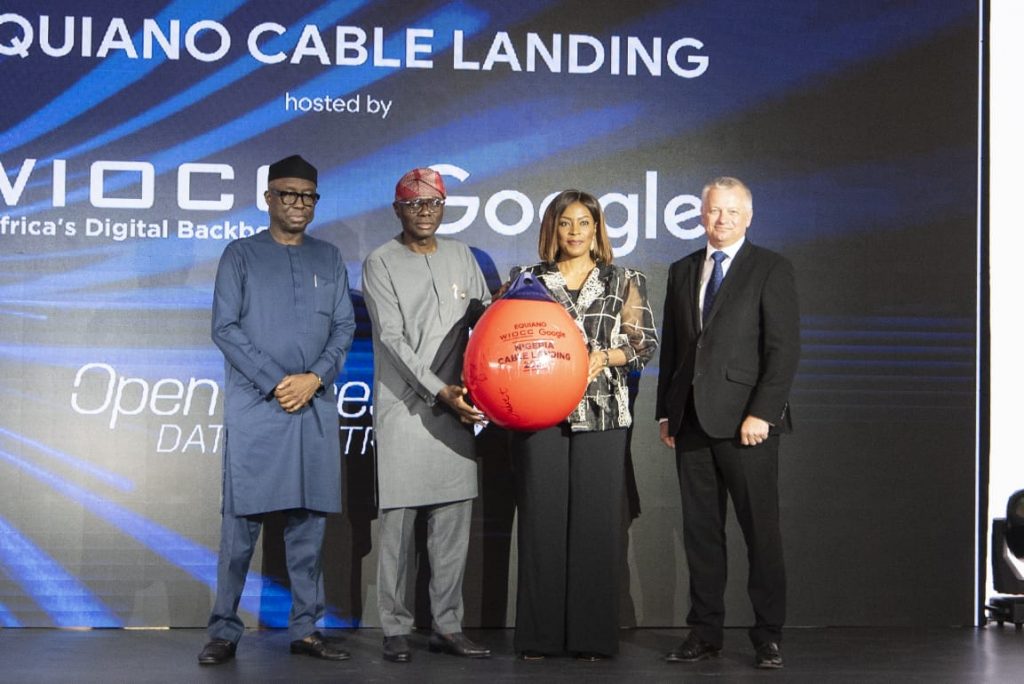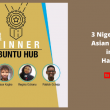Yesterday, Google announced the arrival of its mega subsea cable, Equiano to Lagos, Nigeria, just a month after its first African landing in Togo. The berthing was marked with an event at the subsea landing and proposed data centre location in Lekki, Lagos.
The Governor of Lagos, Babajide Sanwo-Olu; Federal Minister of Industry, Trade and Investment, Niyi Adebayo; Federal Minister of Communications and Digital Economy, Isa Ali Pantami (represented); Former Minister of Industry Trade and Investment Nigeria, Okechukwu Enelamah; Managing Director, Nigeria Sovereign Investment Authority (NSIA), Uche Orji and others attended the event.


Industry players are optimistic that the Equiano subsea cable will become a critical element in meeting Africa’s current and future connectivity demands when completed later in 2022. In this article, we give details of all Equiano is about.
“Equiano” was a famous African slave
The project has been named after Nigerian-born writer and abolitionist, Olaudah Equiano (also known as Gustavus Vassa). According to his memoir, Olaudah was enslaved as a boy from the Eboe (Igbo) region of the Kingdom of Benin (today Southeast Nigeria). He was taken to the Caribbean and sold as a slave to a Royal Navy officer. He was sold twice after that but bought his freedom in 1766.
As a freeman, Equiano supported the British abolitionist movement in London. He was part of the Sons of Africa, an abolitionist group composed of Africans living in Britain, and he was active among leaders of the anti-slave trade movement in the 1780s. He published his autobiography, The Interesting Narrative of the Life of Olaudah Equiano (1789), which depicted the horrors of slavery.


Equiano did so well in sales that he achieved independence from his benefactors. In his account, Equiano told of his marriage to an English woman who he lived with in Soham, Cambridgeshire, where they had two daughters.
Today, Equiano’s book is considered an exemplary work of English literature by a new African author. He travelled throughout England, Scotland and Ireland promoting the book. He worked to improve economic, social and educational conditions in Africa. Specifically, he became involved in working in Sierra Leone, a colony founded in 1792 for freed slaves by Britain in West Africa.
Google x WIOCC x OADC
Let us define the roles of some of the key stakeholders and the relationship matrix for your understanding.
Equiano is fully funded by Google and is the driver of the project. It is the third private international cable Google is investing in after Dunant and Curie, and its 14th subsea cable investment globally.
This is part of the company’s commitment to helping increase internet access across Africa. Speaking at the event, Juliet Ehimuan, Director, West Africa at Google said:
Google is committed to supporting Africa’s digital transformation and we are excited to see the impact of the landing of Equiano in Nigeria. We’ve worked with established partners and in-country experts to guarantee that Equiano has the greatest potential effect in Nigeria and throughout Africa.
Juliet Ehimuan
WIOCC
WIOCC is Google’s leading partner company that will ensure the deployment of carrier-scale, future-proofed network infrastructure in Africa. WIOCC will operate exclusively as a wholesaler in the space. Speaking at the event, Chris Wood, Chief Executive Officer of WIOCC said:
We are proud to have been selected by Google as the landing partner for the Equiano cable in Nigeria, landing the cable directly into the OADC Lagos data centre. From there it will be extended to other data centres across Lagos.
Chris Wood
Chris Wood said that WIOCC has invested over $300 million into its pan-African and submarine and terrestrial fibre infrastructure network. The network now seamlessly interconnects 30 African countries across more than 55,000km of a terrestrial fibre-optic network and it serves more than 500 African locations.


OADC
For efficient deployment, the Equiano cable is being landed into a high-specification Open Access Data Centre (OADC) in Lekki Lagos. OADC Lagos is designed to be the most client-centric data centre in West Africa. The facility has been designed to generate its own power of approximately 20MW. It has more than 7,200m2 of white space – sufficient for 3,200 racks, when fully operational.
OADC is being linked to existing subsea cable systems, data centres and IXPs via diverse open-access ducts.
The cable has a 144 TPBs capacity!
Equiano will be the first subsea cable to incorporate optical switching at the fibre-pair level, rather than the traditional approach of wavelength-level switching. This greatly simplifies the allocation of cable capacity.
The cable which starts in Portugal runs more than 12,000km along the West Coast of Africa- through Lomé, Togo; Lagos, Nigeria; Swakopmund, Namibia; Rupert’s Bay, Saint Helena and Melkbosstrand, South Africa.


Globally, sub-Saharan Africa remains the most underserved region in terms of internet infrastructure. Penetration stands at 29%, while for the entire continent (including North Africa), it is 40%. Nigeria is sub-Saharan Africa’s largest economy. Still, the share of people using the internet stands at approximately 35.5% as of 2020.
The cable is a 12 fibre pair. It can provide a speed capacity of up to one hundred and forty-four terabits per second (114tpbs). By implication, the new network has the capacity to increase internet speed sixfold from 11 Mbps in 2021 to 65 Mbps in 2025, increase internet penetration by six times and reduce internet prices across Africa by 21%.
With a well-developed connectivity infrastructure, Africa’s digital transformation and its internet economy are projected to grow from USD 115 billion in 2020 to USD 180 billion in 2025 and USD 712 billion by 2050.


Improved connectivity will also accelerate job creation across the continent.
Google estimates that Equiano will indirectly create 1.6 million new jobs (330,000 per year) driven by the expansion of the digital economy and peripheral sectors between 2022 and 2025,
How can you access this internet?
When Facebook launched its Free Basics internet service in Nigeria in 2016, the platform allowed users to access listed websites at no cost in partnership with Airtel.
Free Basics was launched in 21 African countries to provide free internet service to a combined population of 635 million.
But the Google service will not be offered through free public wifi or through free offerings to subscribers by network service providers like Airtel (as in the case of Facebook). According to Atoyese, one of OADC’s engineers, the company will be focused on B2B offerings mainly.


Popularly recognised as Africa’s carriers’ carrier, WIOCC will offer carriers, content providers, cloud operators, ISPs and mobile operators reliable, high-capacity connectivity in more than 30 African countries and key global financial and commercial centres. As said above, the company will operate exclusively as a wholesaler.
That means that end-users will feel the improved service from their exister providers. Google is not launching a service provider outlet or offering broadband directly (at least as much as we know).






